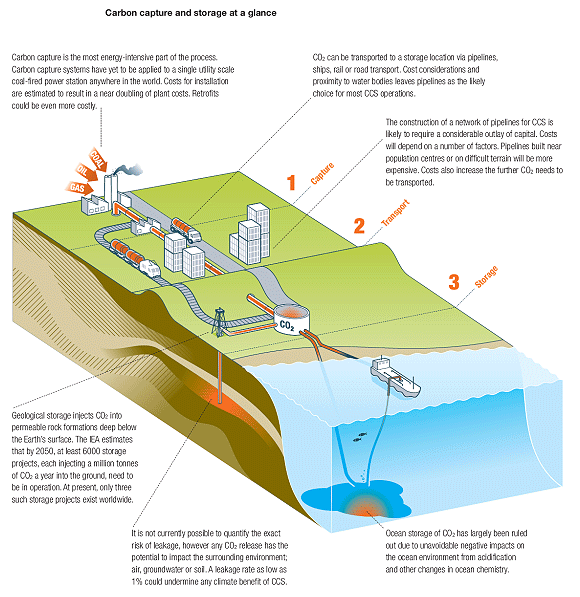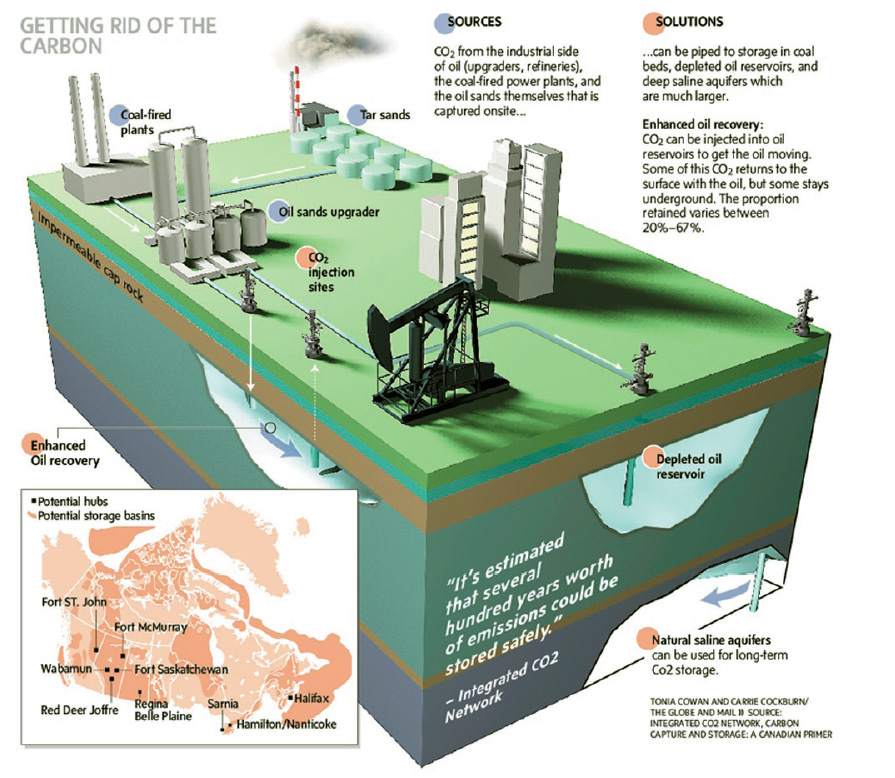

Clean Coal - The Devil Lies in the Details
GLOBE-Net
06-Nov-2008
GLOBE-Net (November 6, 2008) - There was a lot of talk about "Clean coal technology" during the election campaign in the United States. Both the Democratic and Republican nominees wanted to place it at the forefront of their energy independence strategy. John McCain pledged to speed up its development with a $2 billion a year investment until 2024. Barack Obama wanted to build "five ’first-of-a-kind’ commercial scale coal-fired plants with carbon capture and sequestration."

Essentially, McCain and Obama want power station smokestacks to grab the carbon dioxide (CO2) they emit when they burn coal. The CO2 would be transported to a storage site via pipelines, ships, rail or trucks. There it would be injected into rock formations deep below the Earth’s surface. Since the U.S. is the world’s second largest emitter of CO2 emissions after China, the technology would reduce air pollution substantially.
Yet both candidates slid over the details that make their proposals more complicated than meets the eye. First, there is question of cost. The technology exists to capture and store CO2 - the oil industry has been doing it for years -- but it has never been applied in a large-scale commercial project.
"There’s no such thing as clean coal. It’s non-existent."
Former U.S. Vice-President Al Gore
In 2003 President George W. Bush hailed a public-private partnership to build a near-zero emission coal plant - FutureGen -- by 2012. But the plant never left the development stage and astronomical cost overruns convinced the federal government to pull the plug in January 2008.
Second, the pumping of carbon gas into the ground has cause for concern for both the industry and environmentalists. What worries plant owners is the risk that lawyers pose to their investment. "Without clear rules and guidelines on the question of liability at the state and federal level,
the industry would probably be reluctant to deploy this technology," says Michael Catanzaro of energy firm PPL Corp. during an interview with the Wall Street Journal.

Environmentalists wonder if the underground deposits of carbon dioxide will stay leak proof. The gas could migrate sideways into groundwater or upwards to the surface. "Undetected fractures in cap rocks or those created by injecting CO2 at too high a pressure can provide another avenue for CO2 to escape. Improper design and construction of wells can also create opportunities for leakage," explains a Greenpeace report on carbon capture.
There is also a concern that the technology will not get to the market until too late. The industry’s own predictions do not foresee carbon capture and storage becoming viable before 2020 at the earliest. But to avoid the worst excesses of climate change, global greenhouse gas emissions must peak by 2015 and start falling to at least 50 percent by 2050.
Finally, there needs to be a huge processing and transportation infrastructure in place to make a meaningful dent in climate change. According to the Union of Concerned Scientists, the infrastructure would have to handle a volume of liquefied carbon dioxide rivaling that of the oil consumed by the United States. The annual storage space needed for the emissions of a typical 600-megawatt plant would be about four times the volume of the Empire State Building.
"Even if carbon capture and storage works on a commercial scale, coal will still be dirty," says Steve Clemmer UCS Clean Energy Program research director and co-author of the report Coal Power in a Warming World. "The technology doesn’t address the environmental threat posed by mining, transporting and disposing of coal."
The Union of Concerned Scientists thinks the U.S. federal government should first fund five to 10 full-scale demonstration projects. These would allow experts to determine if carbon dioxide can be stored indefinitely and in what type of underground geological formations.
One solution may come from India and China. These two countries, according to the The Wall Street Journal, have been at the forefront of new research into underground coal gasification. This technology, pioneered by the Soviet Union during the 1930s, involves drilling a borehole into a coal seam which is then ignited. The gases produced by the combustion are forced to the surface through a second borehole where they are harnessed to feed turbines. The Wall Street Journal says 30 such projects - at various stages of preparation -- currently exist in China.
Regardless, coal will remain an essential part of the world economy for years to come. The International Energy Agency predicts that there will be a 73 percent increase in global demand for coal by 2030. Clean coal technology might provide a solution to climate change, but even with massive governmental support, it is not likely to make a significant difference in the near future.
For more information:
Carbon capture and storage - Reality or illusion (GLOBE-Net)
Carbon capture and storage - Reality or illusion
GLOBE-Net23-Mar-2008
VANCOUVER, March 23, 2008 (GLOBE-Net) -Carbon capture and storage has become a hot topic in the business press recently, touted by some as the emission reducing key to continued use of fossil fuels, and panned by others as a great green scam perpetrated by the oil and gas industry. The truth is carbon capture and storage is anything but an illusion; but making it a commercial scale reality - at least in Canada - will require a great deal more than what has been put on the table so far.
Many countries are relying on CCS as one of the main technological fixes to the seemingly intractable problem of meeting their emission reduction commitments while continuing to source their energy needs from fossil fuels.
CCS is at the core of the recently announced federal strategy to reduce greenhouse gas emissions. The proposed regulatory regime will require that carbon capture and storage (CCS) be built into all new coal-fired power plants and oil sands facilities beginning in 2012, and be fully operating by 2018.
The Government of Alberta has committed to a 14-per-cent cut in emissions over 2005 levels by 2050 and has struck an industry-government council to develop a "made-in-Alberta plan" for the immediate advancement of carbon capture and storage technology.
Leaving aside the vagueness of both the Alberta and federal government strategy statements, the hard reality is that the technologies upon which CCS is based are still in their early stages and the likely costs for their full deployment on a scale that would actually make a difference in reducing CO2 emissions are astronomical.
Conceptually, there is nothing particularly new in capturing and storing carbon. The technology to capture CO2 and to pump it underground is commercially available and fairly well developed. Although CO2 has been injected into geological formations for various purposes such as enhancing oil recovery from near depleted oil reservoirs, the long term storage of CO2 is a relatively untried concept. No large scale power plant in the world operates with a full carbon capture and storage system.
 Click for larger image |
Canada is among the world’s leaders in terms of research in this area. EnCana Corporation, one of North America’s leading natural gas producers, manages the world’s largest greenhouse gas sequestration project at its Weyburn Saskatchewan oilfield operation.
EnCana purchases CO2 from a coal gasification plant in North Dakota and ships it to Weyburn via pipeline. Apart from giving new life to an old field, the Weyburn sequestration project, a world-scale research initiative operated under the auspices of the International Energy Agency, has confirmed that Weyburn is a suitable reservoir for the long-term geological storage of CO2.
As noted by Rhona DelFrari, EnCana’s Media Relations Advisor, the first phase of the IEA research project is already complete and the results suggest that more than 99% of the CO2 sequestered at Weyburn will safely remain in the ground for at least 5,000 years.
CCS in geological formations involves injecting CO2 into rock layers, usually depleted or near-depleted oil or gas fields, deep saline aquifers (porous rock layers containing salty water deep underground, or coal seams that cannot be mined.
A joint Alberta - Federal Government Task Force Report (Canada’s Fossil Energy Future: The Way Forward on Carbon Capture and Storage) released in January 2008, cites the stable sedimentary rock formations of the Western Canadian Sedimentary Basin (WCSB) as Canada’s biggest advantage for CO2 storage.
"The reservoirs that securely held Canada’s vast oil and gas reserves for hundreds of millions of years can be used to store CO2, and the deep saline aquifers underlying these rock units hold several magnitudes more storage potential," cites the report, which also notes that the co-location of large industrial GHG sources with this storage opportunity makes the WCSB a world-class location for CCS.
The Task Force report optimistically posits that CCS is unique in that it can be built on the technical and institutional base of the existing fossil energy infrastructure and can be implemented quickly (within a decade) using existing technology as the world develops next-generation, longer-term energy solutions.
The report’s observation with respect to the time line for CCS deployment is roughly consistent with other estimates. According to the Office of Technology Assessment at the German Parliament (TAB), CO2 capture will become available for large scale use in 2020 at the earliest.
Where the problem arises, as pointed out by Bruce Cox, executive director of Greenpeace Canada in a March 18, 2008 Globe and mail commentary (Why Carbon Capture is an Illusion), even if CCS works it will kick in too late to avoid the worst excesses of climate change. Cox notes the international consensus is that global greenhouse gas emissions must peak by 2015 then start falling to at least 50 per cent by 2050.
Industry’s own predictions don’t foresee carbon capture and storage becoming commercially viable before 2020 or 2030, and that will miss the critical threshold for turning things around, notes Cox.
He may be right, but that does not obviate the need to start the ball rolling now.
"By opposing CCS, environmental groups are gambling that we can make the huge cuts in CO2 emissions we need simply by improving our energy efficiency and using renewables like solar and wind power. They may be right. But if they’re wrong, they could cripple action against climate change - the greatest environmental threat of our age. It’s a dangerous, and seriously imprudent, gamble." - Thomas Homer-Dixon.
Canada’s efforts to date are promising, but not nearly enough. The recent federal budget provided $240 million in trust for a full-scale commercial demonstration of carbon capture and storage in the coal-fired electricity sector. This is based on the premise that reducing carbon emissions from coal-fired power plants will make a significant contribution to achieving Canada’s greenhouse gas emission reduction objectives.
Budget 2008 also provided $5 million to the Institute for Sustainable Energy, Environment and Economy at the University of Calgary to work with a broad range of stakeholders to resolve "a number of regulatory, economic, and technological issues that need to be resolved to accelerate deployment of carbon capture and storage technologies."
As noted in a recent GLOBE-Net editorial (Budget 2008 - More Blue than Green), the jury is still out as to how effective the measures announced in Budget 2008 will be in terms of stimulating the development and commercialization of the technologies needed to cope with the inevitable impacts of climate change. But with respect to carbon capture and storage, a great deal more that $240 million will be required.
Alberta’s plan for reducing greenhouse gas emissions involves fines for companies that exceed per-barrel emissions limits. Such fines are expected to put upwards of $177 million a year into the government’s Climate Change and Emissions Management Fund, proceeds from which will help pay for projects that reduce the cost of separating carbon dioxide from other emissions or support carbon capture and storage.
It still won’t be enough to make serious inroads into changing industry behaviour or to bring on line a network of carbon capture pipelines and sequestration facilities.
The European Union is well aware of this fact. In January 2008 the EU Commission set out a Directive to enable environmentally-safe capture and geological storage of carbon dioxide in the EU as part of a major legislative package designed to balance the need for urgent action to tackle climate change with the need to ensure security of energy supply. The plan calls for a suite of technologies that would ensure the carbon dioxide emitted by industrial processes can be captured and stored underground and financial aid to enable member governments to support CCS demonstration plants.
Canadian governments, Canadian industry and Canadian consumers will have to spend a great deal more than what is already on the table to finance proving the technological and commercial feasibility of CCS and to deploy that technology on a scale sufficient to make a real difference.
It is the prospect of big money and big profits that has caused some environmental groups to pan CCS as "a public relations smokescreen for the tar sands and coal-fired electricity generation" industries.
As noted by David Keith at the University of Calgary and Thomas Homer-Dixon at the University of Toronto CCS will be a big-industry technology that will require huge outlays of capital, armies of scientists, engineers and construction workers, and will also generate huge profits.
"So when environmental groups saw that industry representatives dominated the blue-ribbon panel, they assumed that the energy industry was once again positioning itself to line its pockets, and attacked its recommendations", the two note in a recent Globe and Mail article entitled A Win-Win-Win Situation.
They point out that "It’s time that Canada’s environmental groups freed themselves of this ideological straitjacket. They need to acknowledge that modern capitalism is the most dynamic, innovative and adaptive economic system human beings have ever invented."
They note also that while capitalism has fuelled our climate problem and that many big businesses have lobbied hard to block serious action, the world is not going to solve the problem without capitalism’s help, "albeit capitalism that’s ultimately guided by strong government imposed constraints."
This point was made very clear during the recently concluded GLOBE 2008 Conference in a Special Session on Carbon Capture and Storage. The assembled group of experts noted that CCS is proven, safe and Canada’s best option for reducing greenhouse gas emissions, but the technology will not become commercially viable without government assistance.
The unanimous opinion of each panelist was that CCS technology was ready for further development and deployment, but without proper climate change regulation and a realistic price on carbon, large scale projects were too risky and potentially uneconomical. (See GLOBE-Net article GLOBE 2008 Session Update: Carbon Capture and Storage)
The same point was made in a recent report from the Massachusetts Institute of Technology (MIT) that stressed CCS was the critical enabling technology that would help reduce CO2 emissions significantly while also allowing coal to meet the world’s pressing energy needs. The two key factors needed to ensure its deployment were a significant charge for GHG emissions (a ‘carbon price’), and "large-scale demonstration projects of the technical, economic and environmental performance of CCS", said the expert panel behind the report. (See GLOBE-Net article: Is ’Clean’ Coal Possible?)
Carbon capture and storage is definitely not an illusion; but making it a commercial scale reality - at least in Canada - will require a great deal more than what has been put on the table to date. The Weyburn Saskatchewan project is a start; but much, much more will be required.
Information Sources
IPCC Special Report Carbon Dioxide Capture and Storage
Canada’s Fossil Energy Future: The Way Forward on Carbon Capture and Storage
IEA GHG Weyburn-Midale CO2 Monitoring and Storage Project
The Canadian CO2 Capture and Storage Technology Network
Publication Date: 3/25/2008
For More Information: GLOBE-Net